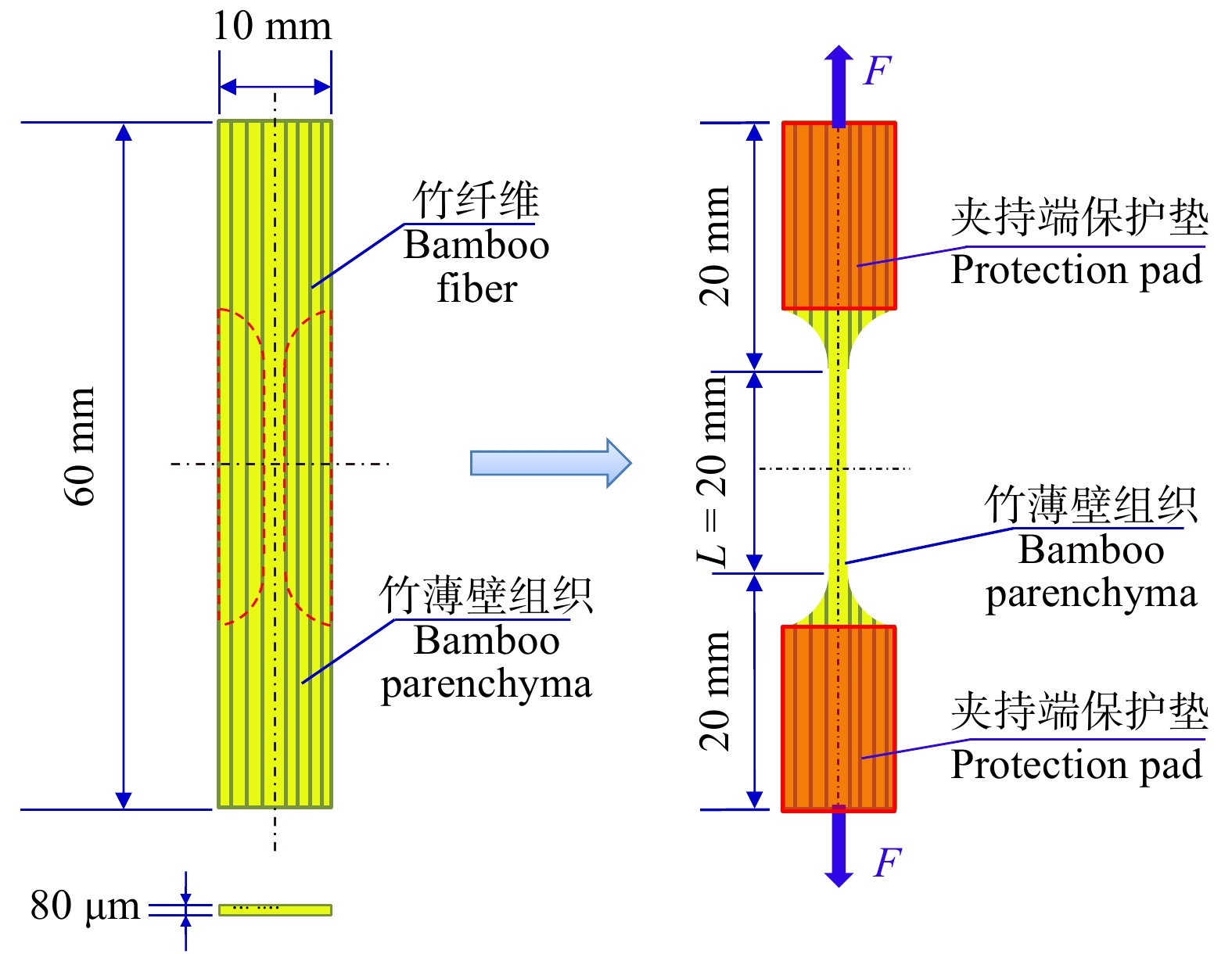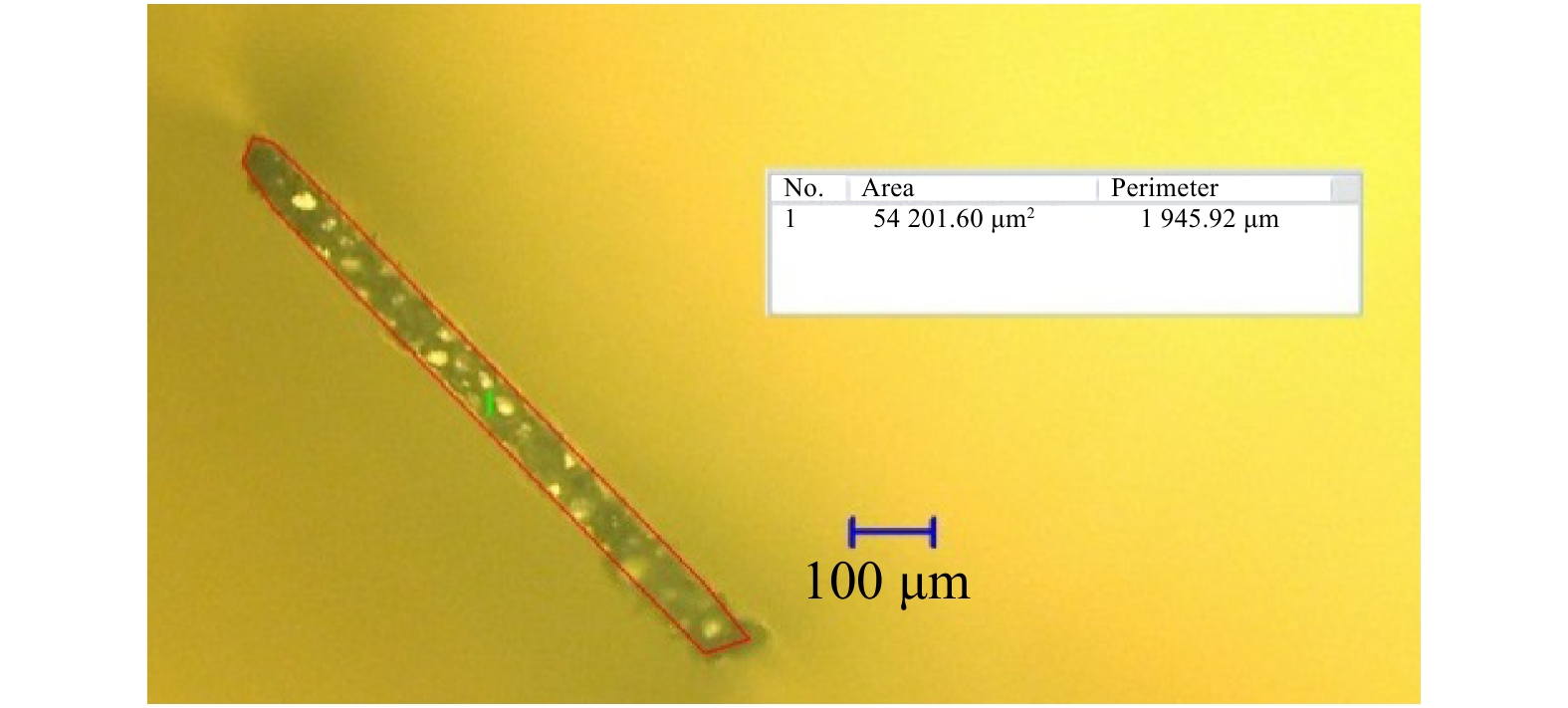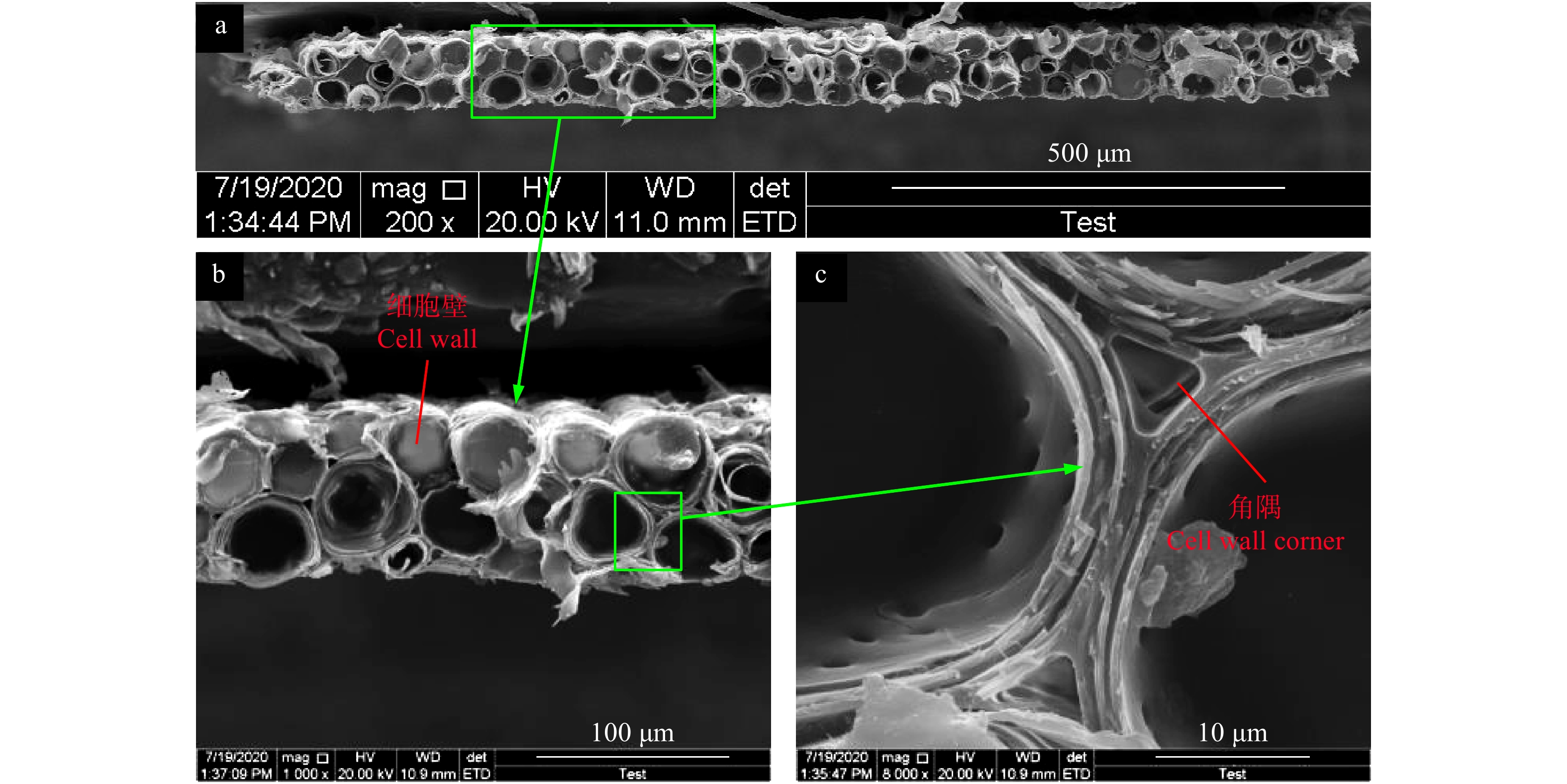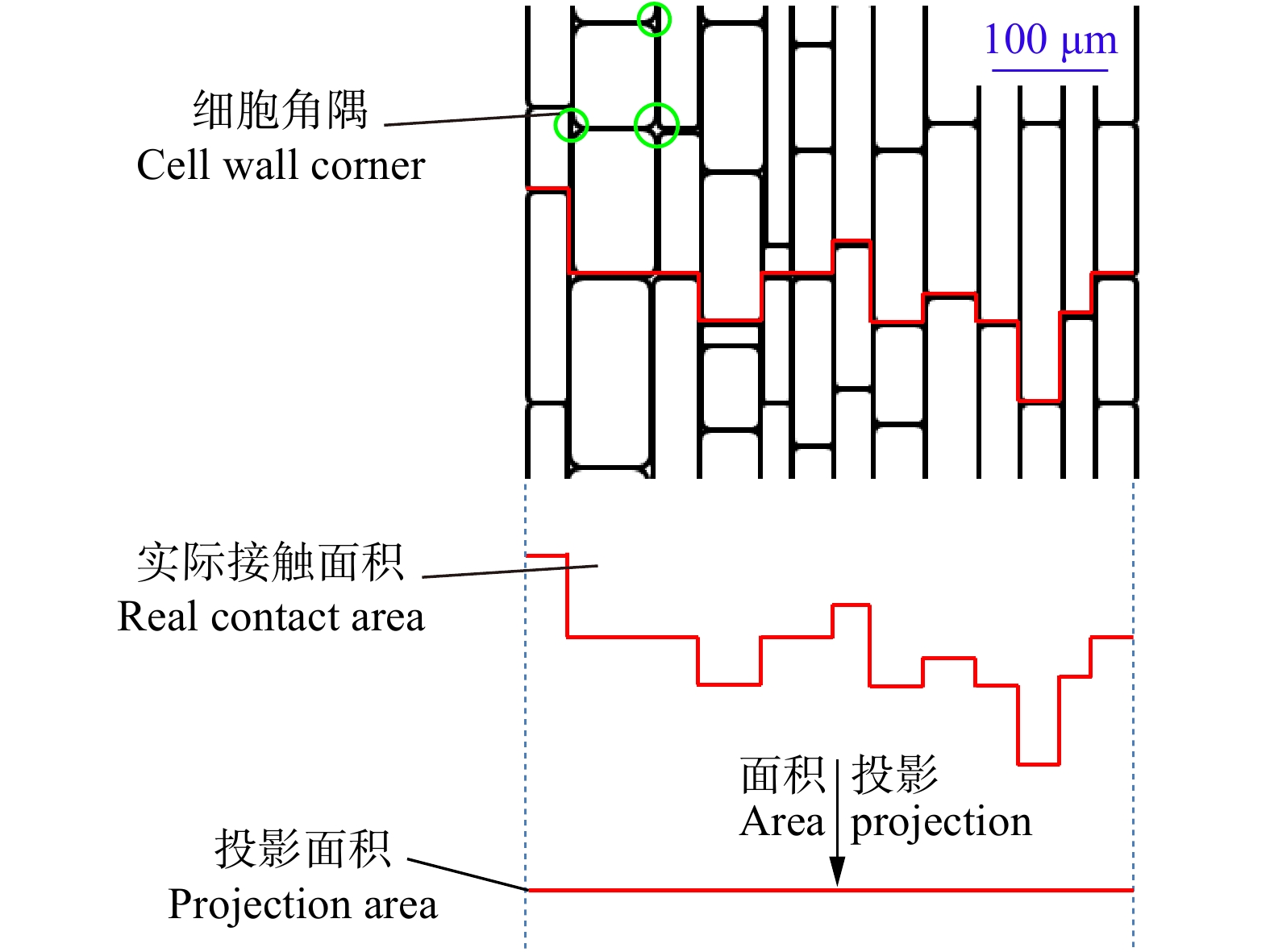Tensile properties and its variation pattern of bamboo parenchyma
-
摘要:目的 从力学角度看,竹材的薄壁组织扮演基体的角色,而因其几何形貌的限制,目前针对薄壁组织开展的力学方面的相关研究较少。探索薄壁组织的力学性能,尤其是基体材料属性的赋值,对竹材精细化仿真模型的建立起到关键作用,进而提高模拟分析结果的准确性。方法 以毛竹材为研究对象,7组试样取自同一竹秆不同高度处节间,软化后切厚度为30和80 μm的弦切片,其中厚度为30 μm的切片用于测试薄壁细胞形态参数,厚度为80 μm的切片用于制作有效试验段仅含薄壁组织的拉伸试样,并在力学试验机上结合光学引伸计完成竹材薄壁组织的拉伸试验,计算分析其抗拉强度、弹性模量和失效应变。结果 竹材薄壁细胞长、宽、腔径和双壁厚在竹秆高度方向上无明显的变异规律;薄壁组织的平均抗拉强度为13.08 MPa,抗拉弹性模量为830.86 MPa,失效应变为1.98%,三者在竹秆高度上的变异规律均不明显;竹材薄壁组织拉伸性能与薄壁细胞形态之间的线性相关性较低。对薄壁组织拉伸失效断口的分析表明其拉伸失效的实质是胞间层分离与细胞壁断裂,本试验采用的毛竹材薄壁组织的平均抗拉强度在13.08 ~ 34.82 MPa之间。结论 试验方法与结果均可靠,试验结果将为全面而深入地了解竹材力学性能及其数学模型的建立提供重要的参考价值,另外本试验方法将为植物材料力学性能的相关研究提供参考。然而,为提高测量结果的准确性还需进一步的深入研究,竹材薄壁细胞组织构造在竹秆高度方向上的变异规律与其力学性能之间的关系仍需探索。Abstract:Objective Bamboo is a kind of typical unidirectional long fiber reinforced composite material. The reinforcement phase is bamboo fiber, and the matrix is parenchyma. At present, there are few researches on the mechanical properties of bamboo parenchyma limited by its geometrical morphology, while its mechanical parameters do play important role in building fine numerical model of bamboo, especially the assignment of matrix attribute.Method In this paper, 7 groups of bamboo parenchyma from different heights of culm were extracted by slicing, the slices with a thickness of 30 μm were used to geometrical morphology of parenchyma cells and the slice with a thickness of 80 μm was used to perform tensile tests. The variations of its geometrical morphology and tensile properties including tensile strength, tensile elastic modulus and failure strain in the height direction of bamboo culm were tested and studied.Result The results showed that in the height direction of bamboo culm, geometrical morphology of bamboo parenchyma had no obvious variation pattern. The average tensile strength, tensile elastic modulus and failure strain of parenchyma were 13.08 MPa, 830.86 MPa and 1.98%, and all the three tensile parameters had no obvious variation pattern in the height direction of bamboo culm. The linear regression analysis results showed that there were low correlationship among parenchyma tensile properties and parenchyma cell geometrical morphology. Tensile failure mechanism of parenchyma was analyzed, and it was found that the tensile failure of parenchyma was the tensile failure of parenchyma cell interface and cell wall, thus the tensile strength of bamboo parenchyma here ranged from 13.08 to 34.82 MPa actually.Conclusion The test method and results are all reliable, which could provide theoretical basis for the further study of mechanical properties of bamboo, especially for the numerical simulation of bamboo. However, deep study should be performed to improve the accuracy of test results, and the relationship between parenchyma mechanical properties and the variation pattern of parenchyma cell organization structure still need to be explored.
-
Keywords:
- bamboo /
- parenchyma /
- cell morphology /
- tensile property /
- failure mechanism
-
-
表 1 毛竹材节间薄壁细胞形态参数
Table 1 Parameters of geometrical morphology of bamboo parenchyma cells
节间编号
Internode No.长
Length/µm宽
Width/µm双壁厚
Cell wall thickness/µm腔径
Lumen diameter/µm长宽比
Ratio of length to width3 167.23 (16.33%) 43.18 (11.06%) 9.73 (13.69%) 32.77 (13.61%) 3.90 5 156.97 (14.85%) 50.18 (8.21%) 10.94 (13.94%) 38.33 (9.67%) 3.15 7 168.88 (17.63%) 44.27 (12.14%) 7.41 (15.93%) 37.02 (14.03%) 3.85 9 125.16 (16.42%) 50.88 (10.32%) 11.83 (16.71%) 39.30 (11.67%) 2.49 11 152.37 (15.16%) 47.31 (7.89%) 11.93 (14.73%) 34.93 (8.03%) 3.24 13 151.89 (13.32%) 46.22 (16.60%) 9.69 (18.79%) 36.91 (19.51%) 3.35 15 157.23 (13.60%) 47.41 (11.61%) 8.98 (15.51%) 38.53 (13.13%) 3.36 注:表中括号内数据为各组数据相应的变异系数。下同。Notes: data in brackets are the corresponding variable coefficients. Same as below. 表 2 毛竹材节间薄壁组织拉伸试验结果
Table 2 Tensile test results of bamboo parenchyma
节间编号
Internode No.抗拉强度
Tensile strength/MPa抗拉弹性模量
Tensile elastic modulus /MPa失效应变
Failure strain/%3 14.46 (16.87%) 759.21 (21.59%) 2.08 (18.84%) 5 15.59 (21.45%) 979.40 (20.11%) 1.97 (23.33%) 7 13.66 (19.91%) 853.51 (22.92%) 1.84 (23.71%) 9 15.10 (21.06%) 1 118.86 (20.15%) 1.88 (18.82%) 11 9.35 (18.14%) 552.17 (22.80%) 2.03 (22.42%) 13 9.92 (19.25%) 726.36 (21.38%) 1.73 (20.61%) 15 13.47 (20.91%) 807.88 (23.65%) 2.25 (21.82%) 平均值 Average value 13.08 (18.90%) 828.20 (22.03%) 1.97 (8.72%) 表 3 毛竹材节间薄壁组织抗拉强度、弹性模量和失效应变差异显著性分析结果
Table 3 Significance difference analysis results of tensile strength, tensile elastic modulus and failure strain of parenchyma
指标
Index差异源
Source of variance平方和
Sum of squares自由度
df平均值平方
Mean squareF检验
F test显著性
Significance level抗拉强度
Tensile strength组间 Between groups 2570.071 166 15.482 0.000 显著 Significant 组内 Within group 0.000 1 0.000 总计 Total 2570.071 167 弹性模量
Tensile elastic modulus组间 Between groups 1499.660 105 14.282 0.000 显著 Significant 组内 Within group 0.000 0 0.000 总计 Total 1499.660 105 失效应变
Failure strain组间 Between groups 1656.000 105 15.771 0.000 显著 Significant 组内 Within group 0.000 0 0.000 总计 Total 1656.000 105 注:F值小于0.05为差异显著。Note: difference is significant when F value is below 0.05. -
[1] 江泽慧. 世界竹藤[M]. 沈阳: 辽宁科学技术出版社, 2000. Jiang Z H. Bamboo and rattan in the world[M]. Shenyang: Liaoning Science and Technology Publishing House, 2000.
[2] Dixon P G, Gibson L J. The structure and mechanics of Moso bamboo material[J/OL]. Journal of the Royal Society Interface, 2014, 11: 20140321 [2020−01−27]. http://doi:10.1098/rsif.2014.0321" target="_blank">10.1098/rsif.2014.0321">http://doi:10.1098/rsif.2014.0321.
[3] Ahvenainen P, Dixon P G, Kallonen A, et al. Spatially-localized bench-top X-ray scattering reveals tissue-specific microfibril orientation in Moso bamboo[J/OL]. Plant Methods, 2017, 13: 5 [2019−12−02]. https://link.springer.com/article/10.1186/s13007-016-0155-1.
[4] Abe K, Yano H. Comparison of the characteristics of cellulose microfibril aggregates isolated from fiber and parenchyma cells of Moso bamboo (Phyllostachys pubescens)[J]. Cellulose, 2010, 17(2): 271−277. doi: 10.1007/s10570-009-9382-1.
[5] 杨云芳, 刘志坤. 毛竹材抗拉弹性模量及抗拉强度[J]. 浙江林学院学报, 1996, 13(1):21−27. Yang Y F, Liu Z K. Phyllostachys pubescens wood: tensile elastic modulus and tensile strength[J]. Journal of Zhejiang Forestry College, 1996, 13(1): 21−27.
[6] 黄盛霞, 马丽娜, 邵卓平, 等. 毛竹微观构造特征与力学性质关系的研究[J]. 安徽农业大学学报, 2005, 32(2):203−206. doi: 10.3969/j.issn.1672-352X.2005.02.017. Huang S X, Ma L N, Shao Z P, et al. Relationship between microstructure characteristics and mechanical properties of Moso bamboo[J]. Journal of Anhui Agricultural University, 2005, 32(2): 203−206. doi: 10.3969/j.issn.1672-352X.2005.02.017.
[7] 邵卓平. 植物材料断裂力学[M]. 北京: 科学出版社, 2012. Shao Z P. The fracture mechanics of plant material[M]. Beijing: Science Press, 2012.
[8] Wu Y, Wang S Q, Zhou D G, et al. Evaluation of elastic modulus and hardness of crop stalks cell walls by nano-indentation[J/OL]. Bioresource Technology, 2010, 101: 2867−2871 [2019−12−06]. https://doi.org/10.1016/j.biortech.2009.10.074.
[9] Huang Y H, Fei B H, Wei P L, et al. Mechanical properties of bamboo fiber cell walls during the culm development by nanoindentation[J]. Industrial Crops and Products, 2016, 92: 102−108. doi: 10.1016/j.indcrop.2016.07.037.
[10] 费本华. 木材细胞壁力学性能表征技术及应用[M]. 北京: 科学出版社, 2014. Fei B H. Characterization technique of mechanical properties of wood cell walls and its application[M]. Beijing: Science Press, 2014.
[11] Gibson L J, Ashby M F, Harley B A. Cellular materials in nature and medicine[M]. Cambridge: Cambridge University Press, 2010.
[12] Dixon P G, Muth J T, Xiao X, et al. 3D printed structures for modeling the Young’s modulus of bamboo parenchyma[J/OL]. Acta Biomaterialia, 2018, 68: 90−98 [2020−03−02]. https://doi.org/10.1016/j.actbio.2017.12.036.
[13] Zhao X Y, Wang G N, Wang Y Z. Micromechanical modeling in determining the transverse elastic moduli and stress distributions of bamboo[J]. Journal of Materials Science, 2018, 53(4): 2553−2565. doi: 10.1007/s10853-017-1692-3.
[14] Palombini F L, Kindlein W, De Oliveira B F, et al. Bionics and design: 3D microstructural characterization and numerical analysis of bamboo based on X-ray microtomography[J/OL]. Materials Characterization, 2016, 120: 357−368 [2020−02−02]. https://doi.org/10.1016/j.matchar.2016.09.022.
[15] Palombini F L, Lautert E L, Mariath J E A, et al. Combining numerical models and discretizing methods in the analysis of bamboo parenchyma using finite element analysis based on X-ray microtomography[J]. Wood Science and Technology, 2020, 54(1): 161−186. doi: 10.1007/s00226-019-01146-4.
[16] Askarinejad S, Kotowski P, Shalchy F, et al. Effects of humidity on shear behavior of bamboo[J]. Theoretical and Applied Mechanics Letters, 2015, 5(6): 236−243. doi: 10.1016/j.taml.2015.11.007.
[17] 李晓丽, 周斌雄, 张怡, 等. 基于共聚焦显微拉曼光谱的毛竹细胞结构和成分研究[J]. 光谱学与光谱分析, 2016, 36(2):413−418. Li X L, Zhou B X, Zhang Y, et al. Revealing the cell structure and formation of bamboo with confocal raman microscopy[J]. Spectroscopy and Spectral Analysis, 2016, 36(2): 413−418.
[18] Habibi M K, Lu Y. Crack propagation in bamboo’s hierarchical cellular structure[J/OL]. Scientific Reports, 2014, 4: 5598 [2020−03−02]. https://doi.org/10.1038/srep05598.
-
期刊类型引用(12)
1. 孙凡,马彦广,刘占民,杨博宁,王辉丽,李伟. 油松高世代种子园亲本选择策略研究. 北京林业大学学报. 2024(04): 28-39 .  本站查看
本站查看
2. 吕寻,李万峰,胡勐鸿,戴小芬,成红梅,委霞. 日本落叶松种子园和优树自由授粉家系选择与利用研究. 西南林业大学学报(自然科学). 2024(03): 1-9 .  百度学术
百度学术
3. 冯健,张金博,杨圆圆,杜超群,徐柏松,曹颖,姚飞. 基于生长性状和SSR遗传多样性分析的红松第二代优树选择研究. 西南林业大学学报(自然科学). 2024(04): 1-7 .  百度学术
百度学术
4. 胡勐鸿,吕寻,戴小芬,李宗德,李万峰. 日本落叶松无性系种子园和优树半同胞家系苗期比较. 东北林业大学学报. 2024(12): 10-17 .  百度学术
百度学术
5. 向华,向文明,向明. 我国用材林优树选择技术研究进展. 湖南林业科技. 2021(02): 89-96 .  百度学术
百度学术
6. 康向阳. 林木遗传育种研究进展. 南京林业大学学报(自然科学版). 2020(03): 1-10 .  百度学术
百度学术
7. 邓乐平,黄婷,王哲,吴惠姗,李晓华,廖仿炎,李义良,郭文冰,赵奋成. 湿地松改良种子园无性系的遗传评价及新一轮育种亲本选择. 林业与环境科学. 2020(04): 1-7 .  百度学术
百度学术
8. 杜超群,赵虎,袁慧,侯义梅,朱于勤,许业洲. 日本落叶松种子园母树生长及种实性状评价. 森林与环境学报. 2019(01): 32-36 .  百度学术
百度学术
9. 王芳,王元兴,王成录,张伟娜,刘卫胜,陆志民,杨雨春. 红松优树半同胞子代家系生长、结实及抗病虫能力的变异特征. 应用生态学报. 2019(05): 1679-1686 .  百度学术
百度学术
10. 金星,于忠峰,苗海伟,于国斌,朱瑞,张丽杰. 辽宁地区油松花粉形态及生活力的测定. 分子植物育种. 2019(15): 5115-5119 .  百度学术
百度学术
11. 康向阳. 关于林木育种策略的思考. 北京林业大学学报. 2019(12): 15-22 .  本站查看
本站查看
12. 苗禹博,朱晓梅,李志娟,贾凤岭,李伟. 不同世代樟子松育种资源遗传评价. 北京林业大学学报. 2017(12): 71-78 .  本站查看
本站查看
其他类型引用(4)




 下载:
下载:








